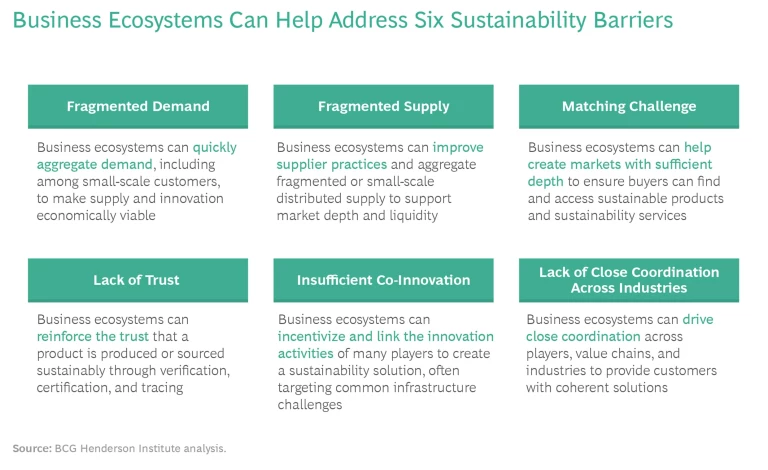Though often complex and difficult to manage, this type of collective action can help companies overcome six barriers that often inhibit their ability to address a sustainability challenge.
The success of ecosystems is a hot topic these days—and rightly so. Apple, for example, has built a powerful business ecosystem of app developers and software players around its iOS operating system. Amazon has similarly built a robust business ecosystem including brick-and-mortar and online retailers. And Visa has built a robust business ecosystem around its payment platform. But what if the power of business ecosystems could be taken a bit further? What if business ecosystems could be leveraged to help save the planet?
That’s not as far-fetched as it may sound. As companies around the world remake their business models to advance their sustainability and boost their business advantage , many are finding that they need to drive change beyond the boundaries of their business. Creating changes in the wider system in which a company operates demands collective action. In some cases, that change is best driven through the creation of a business ecosystem—a specific form of business collective action wherein a dynamic group of independent businesses creates products or services that together constitute a coherent solution to a marketplace or consumer need.
Business ecosystems are complex and often more difficult to develop than alternative approaches to collective action, including partnerships or joint ventures, as well as broad-based corporate-led sustainability alliances. So how do companies determine when a business ecosystem is the best option for a specific sustainability challenge? On the basis of BCG Henderson Institute’s continuing research into sustainable business model innovation (SBM-I) and business ecosystems, we have identified six barriers that often inhibit a company’s ability to address a sustainability challenge, either in their own operations or for their customers, and where business ecosystems could provide a solution:
- Fragmented demand
- Fragmented supply
- Matching challenge
- Lack of trust
- Insufficient co-innovation
- Lack of close coordination across industries
Companies looking to tackle sustainability challenges that exhibit at least one of these barriers should consider creating a business ecosystem to drive collective action toward an ecosystem with enhanced sustainability performance.
The Sustainability Imperative
Our research on more than 115 sustainable business model innovations finds that companies on their own frequently run into constraints within the wider system. That, in turn, limits their ability to achieve greater environmental or societal benefits in a way that is economically or operationally feasible for the business.
Consider the challenge of reducing plastic waste, for example. Major consumer-facing brands are making significant commitments to reduce the use of virgin polyethylene terephthalate (PET), in part by using recycled PET (rPET). But companies looking to switch to rPET face yet another challenge: by 2025, according to BCG estimates, roughly 45% of demand for rPET will be unmet due to limited supply. Filling that gap will require a portfolio of ecosystem interventions that include R&D into such alternatives as biodegradables, the scaling of emerging solutions, and coordinated approaches to expand recycling infrastructure.
This is where collective action can be particularly helpful in removing the constraints that limit the adoption of more sustainable business practices. There are three primary methods for engaging in collective action to remove system sustainability constraints:
- Sustainability Partnerships or Joint Ventures. These arrangements involve formalized agreements among organizations to advance a specific sustainability-related product, service, or initiative. Royal DSM, for example, has partnered with several public, private, and social-sector players—including the government of Rwanda, international development banks, and NGOs—to set up Africa Improved Foods, which will increase access to affordable and nutritious foods. Such partnerships tend to be built by and around a single core business and its own value chain to deliver an SBM-I.
- Broad-Based, Corporate-Led Sustainability Alliances. These alliances are a form of collective action that involves more than two entities with a focus on establishing joint standards, policies, or approaches that advance sustainability. Corporate-led sustainability alliances operating today include One Planet Business for Biodiversity, which focuses on cultivating and restoring biodiversity; the Global Platform for Sustainable Natural Rubber, which aims to make the natural rubber value chain fair, equitable, and environmentally sound; and the Consumer Goods Forum, which focuses on addressing such issues as environmental sustainability and the opportunity to develop products that contribute to global health and well-being.
- Sustainability Business Ecosystems. This is a very specific type of collective action that is often highly focused on addressing a particular market need—and is more than just a kind of loose affiliation, which the word “ecosystem” often evokes. (See “Understanding Business Ecosystems.”) And the approach has been gaining traction. Too Good To Go, for example, has built a business ecosystem to reduce food waste through a marketplace connecting customers with restaurants and stores that have surplus food.
Understanding Business Ecosystems
That’s because a true business ecosystem is not simply a means for connection or collaboration. Rather, it is a collection of independent businesses, orchestrated by a business at the center, that come together to address a specific need in the market. Most important, the solution that is developed by the business ecosystem creates value for every participant. And to make things a bit more complicated, business ecosystems can also incorporate the other two forms of collective action: partnerships and alliances.
Business ecosystems in general have grown more prevalent over the past decade, and they play an increasingly vital role in sustainability efforts. In our study of more than 115 SBM-Is, we found that roughly 30 of them built business ecosystems as a core part of their SBM-I. Notably, many were what we call sustainability front-runners: SBM-Is that most successfully push the boundaries of competition and reimagine their businesses in order to create more robust competitive advantage from sustainability.
In general, business ecosystems are the right choice to address a sustainability challenge that requires combining complementary solutions from different businesses in a highly coordinated fashion. To succeed, the business ecosystem must yield economic benefits for all players along with creating unique value to the end customer. While complex to build, business ecosystems offer the ability to easily access capabilities, scale fast, and achieve flexibility and resilience. In addition, business ecosystems can sometimes be a good interim solution to business sustainability challenges that stem from the absence of clear standards and universal regulation. For example, several players in the world of smart homes—including Samsung (SmartThings), Apple (HomeKit), and Amazon (Alexa)—are expanding their own connected ecosystems while, at the same time, setting up an alliance to work on establishing an industry-unifying, royalty-free connectivity standard called Matter.
Business ecosystems are the right choice to address a sustainability challenge that requires combining complementary solutions from different businesses in a highly coordinated fashion.
Our research has found that sustainability business ecosystems tend to focus on addressing a few specific sustainability challenges and currently tend to be concentrated in a few industries, including financial services, education, and health care. However, business ecosystems remain a relatively untapped opportunity in many other industries.
When Business Ecosystems Make Sense
To determine whether a business ecosystem model is the right solution to a sustainability challenge, companies should assess the nature of the problem they are trying to solve. We have identified six barriers to addressing sustainability challenges that indicate when a business ecosystem approach may offer a viable solution. These barriers are not mutually exclusive; in fact, most sustainability challenges where business ecosystems are successfully deployed exhibit several of them. (See the exhibit.)
Fragmented Demand. Some sustainability challenges are difficult to address because of an inability to aggregate demand so that an SBM-I reaches sufficient scale. This is critical in situations where demand is highly fragmented (often across many small-scale customers), making the economics of serving those customers unattractive. Expanding financial inclusion or access to health or education for rural populations and underserved communities often requires addressing challenges with disaggregated subscale demand.
Consider insurance startup BIMA, for example. The company uses mobile technology to bring vital health and insurance products to more than 35 million customers in ten countries: seven in Asia and three in Africa. BIMA’s platform integrates offerings from various companies (telco providers, mobile money providers, and insurance underwriters) and provides a seamless, user-friendly experience from registration to claims processing with no paperwork involved. To aggregate demand, BIMA employs 3,000 agents to educate and build trust among customers, three-quarters of whom, typically, are accessing insurance services for the first time. Those agents then direct interested customers to BIMA’s multiple channels—including an app, a call center, and social media—to make their purchase.
Fragmented Supply. Supply of certain inputs to a sustainable offering, typically some sort of commodity, can also be a constraint—particularly when supply is highly fragmented (often across many small-scale suppliers). In such instances, transaction costs for customers are prohibitively high. As a result, supply needs to be aggregated before customers can find sufficient market depth to meet their demand or sufficient liquidity in the market exists to enable consistent transactions.
The need for aggregated sustainably produced supply is often an issue for companies that are aiming to improve the practices of small-scale producers throughout their supply chain, particularly in sustainable agriculture. Supply aggregation is also likely to be valuable in the renewable energy sector where energy generation need not only be done at utility scale.
For example, Singapore energy company Sembcorp launched its renewable energy certificate (REC) aggregator platform in 2020 to enable companies to purchase certified renewable energy (from Sembcorp and other suppliers) in lieu of paying government carbon taxes. The platform creates liquidity and flexibility by aggregating sources of RECs and will allow more large energy users to manage their energy portfolios across different sources and geographies and to achieve their renewable energy targets.
Matching Challenge. Companies attempting to market new sustainable products or services can find that high search costs prevent them from transacting with potential customers. In such instances, the challenge is less about scaling supply or demand and more about creating transparency about the offering and consolidating distinct products or services to enable sufficient depth for matching to occur. Sustainability challenges with this barrier include those related to improving resource efficiency, such as increasing the utilization of shipping containers or car sharing, and to providing access to recruitment and job opportunities for underrepresented groups. This barrier can also often be found in challenges in the circular economy, where certain products—such as excess or imperfect foods and second-hand items—require little or no adaptation to make them valuable to other users.
Poshmark plays that market-making role in the fashion industry , facilitating circularity and shopping for second-hand goods. The company—which went public in 2021 and now has more than 80 million registered users in Australia, Canada, India, and the US—has developed a platform for buying and selling items, mainly clothing, in a variety of categories. The platform aims to combine the human connection of a physical shopping experience with the scale, reach, ease, and selection benefits of e-commerce, leveraging a variety of social tools and features designed to drive engagement, including sharing, liking, following, commenting, and real-time virtual-shopping events, such as “Posh Parties.”
Lack of Trust. In some cases, a lack of trust among parties is the major barrier for successful SBM-I, and a business ecosystem can help address this challenge. Trust can be created through verification, certification, and tracing applications. This is particularly important when what matters most to a buyer is how a product was made and what materials went into its production—so, for example, a buyer may choose a sustainably made product over an identical one that was made in a less environmentally friendly way. This could involve certifying that a certain amount of sustainable content (for example, the amount of nonvirgin PET in a bottle) or a product (for example, cotton) has been produced in a sustainable manner. This is also critical in the carbon offset market, where concerns about the underlying quality of offsets have increased in recent years.
The sustainability action platform rePurpose Global, founded in 2016, takes aim at the trust challenge. The platform enables individuals and businesses to offset their plastic footprints through the purchase of so-called plastic credits. These credits are created through the verified removal of low-value plastics from the land and plastics from the ocean, along with investment in recycling facilities in underdeveloped areas and new innovations for plastic alternatives. The platform also provides advisory services to clients to address the root causes of plastic use. It removes roughly 11 million pounds of plastic waste each year and provides fair employment for more than 9,500 waste workers through partner organizations in Colombia, India, Indonesia, and Kenya.
Insufficient Co-Innovation. Frequently, distributed players, in tandem, need to innovate their products or services in order for a coherent solution set for a sustainability challenge to emerge.
Business ecosystems can drive co-innovation among fragmented players, including those in different industries or parts of the value chain, to create a solution to a specific problem. The need for coordination in sustainability often relates to the underlying common infrastructure for a product or service for which clear operational standards are required. Consider the heavy transportation industry, for example. Battery-powered electric vehicles that require a long time to recharge are ill-suited to an industry in which an idle truck is a drag on profitability. Innovations that rely on natural gas, particularly renewable natural gas or blue and green hydrogen, are being developed to decarbonize the heavy transportation industry. But without coordination, truck manufacturers, fuel distributors, and logistics companies are unlikely to adopt any kind of solution quickly.
Business ecosystems can also create the conditions for distributed innovation without a focus on a specific sustainability solution. Here, the business ecosystem provides the underlying platform that supports the exchange of ideas and data involving multiple players. Microsoft’s AI for Good initiative, for example, offers an AI platform for innovation ecosystems that includes cloud computing services, AI tools, and technical support as well as cash awards to facilitate collaboration among key public and private stakeholders to address sustainability challenges.
We believe that there are several SBM-Is that could explore creating a sustainability business ecosystem to address the need for distributed innovation. Consider Salesforce’s Sustainability Cloud platform, for example, which provides clients with data on their greenhouse gas emissions and energy usage. By opening its platform to external solution providers, Salesforce can offer them the opportunity to leverage the underlying data platform to create differentiated solutions for energy and emission management for Sustainability Cloud’s clients across different industries.
Lack of Close Coordination Across Industries. Some sustainability challenges are difficult to address without continuous coordination among different types of stakeholders. Such coordination is especially required in situations where a coherent solution for customers is needed—such as, for example, in health care, where multiple care providers need to be coordinated for each patient. And coordination can be particularly important in circular economy solutions. That’s because multiple players often have a role in a product’s life cycle and therefore must make adaptations to their own products and processes to ensure that circularity can be achieved. Companies involved in the production, use, recycling, and second-life applications of plastic packaging, for example, must coordinate across the entire circular life cycle, including for the collection of waste products from often fragmented end users.
Cityblock Health, a 2017 spinout from Sidewalk Labs (an Alphabet company focused on urban innovation), has cultivated the development of a business ecosystem that addresses the need for close coordination in health care. Cityblock, working with ecosystem participants— including primary care providers, behavioral health specialists, social workers, and community partners that address social needs, such as transportation, housing, and food—provides health care to Medicaid and lower-income Medicare beneficiaries. Cityblock’s proprietary care management platform, Commons, provides a 360-degree view of a patient’s health, enabling care teams to make recommendations on the basis of a holistic understanding of the patient and support coordination among experts. This tech-enabled community care model has proven to be cost-effective, resulting in a 15% reduction in emergency room visits and a 20% reduction in inpatient hospital stays. Cityblock currently serves 90,000 members in Connecticut, Massachusetts, New York, North Carolina, and Washington, DC.
Business ecosystems are an emerging model for tackling sustainability issues confronting society. While such ecosystems add complexity, they also provide access to critical capabilities and resources and the ability to scale rapidly.
To understand if a business ecosystem is the right way to organize to address a sustainability issue, companies must start by identifying the core barrier limiting their progress. In instances where the sustainability challenge exhibits at least one of the barriers outlined above, the development of a business ecosystem may unlock critical constraints and help companies address daunting societal challenges while creating competitive advantage.












